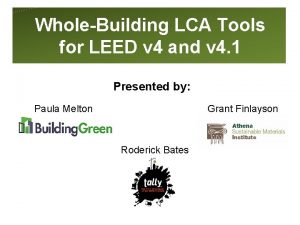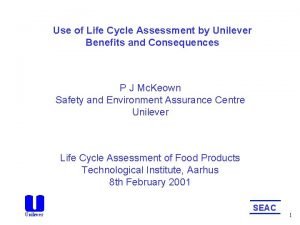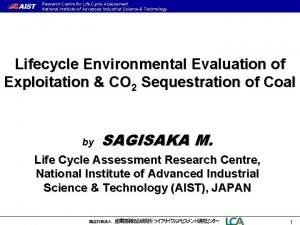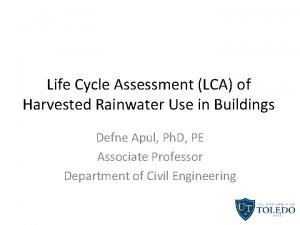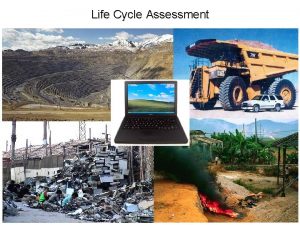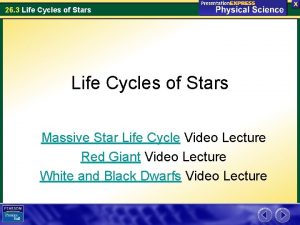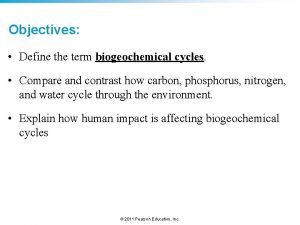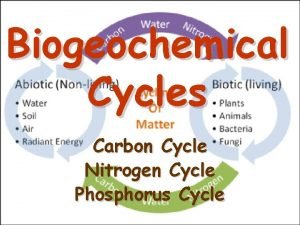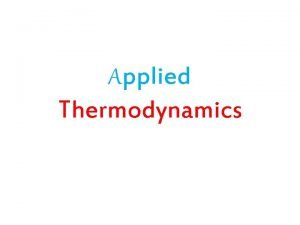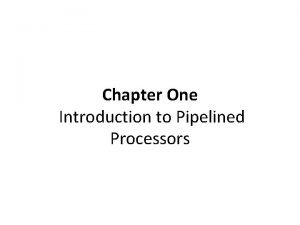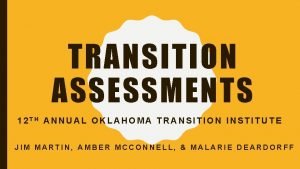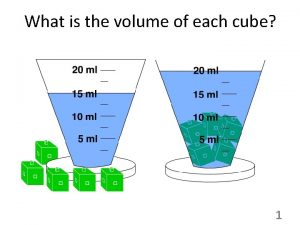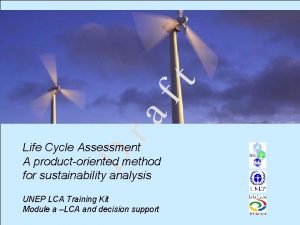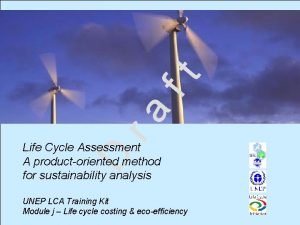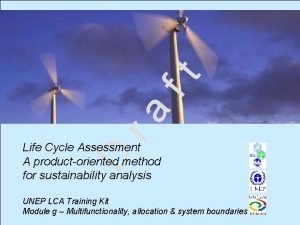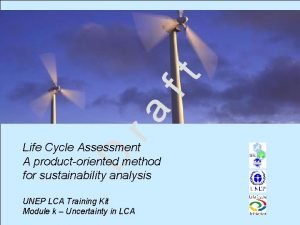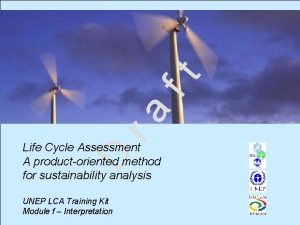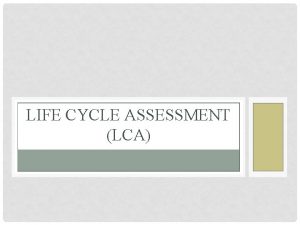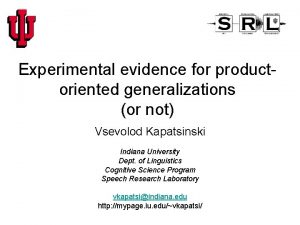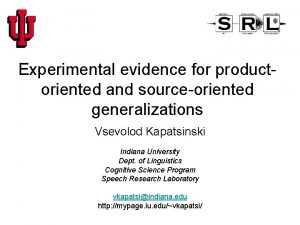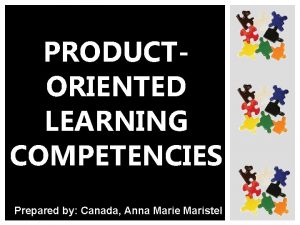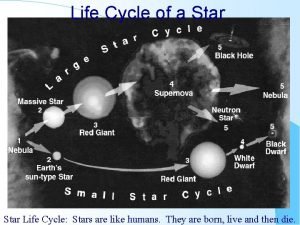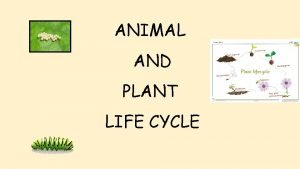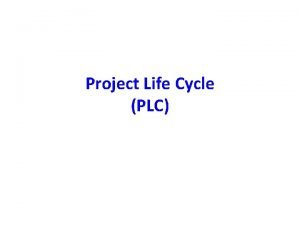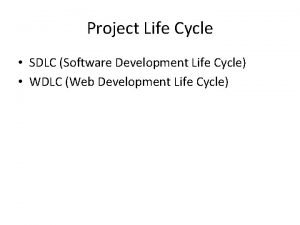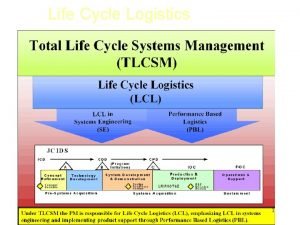ft ra D Life Cycle Assessment A productoriented





























- Slides: 29

ft ra D Life Cycle Assessment A product-oriented method for sustainability analysis UNEP LCA Training Kit Module d – Inventory analysis 1

D ra ft ISO 14040 framework Source: ISO 14040 2

Life cycle inventory analysis D ra ft • ISO: Phase of life cycle assessment involving the compilation and quantification of inputs and outputs, for a given product system throughout its life cycle – International Standard ISO 14041 – Technical Report ISO/TR 14049 • The second phase of an LCA – LCI 3 3 3

Contents D ra ft • • • Economy-environment system boundary Flow diagram Format and data categories Data quality Data collection and relating data to unit processes Data validation Cut-off and data estimation Multifunctionality and allocation Calculation 4

Economy-environment system boundary (1) D ra ft • Demarcation between what is included in the product system and what is excluded • Each product/material/service should be followed until it has been translated into elementary flows (emissions, natural resource extractions, land use, …) 5 5 5

Economy-environment system boundary (2) D ra ft • Example: – upstream: TV transformer copper wire copper ore – upstream: TV electricity high-voltage electricity coal – downstream: TV electronic equipment waste removal of precious and recyclable materials dump site 6 6 6

D ra ft Economy-environment system boundary (3) small wide system boundary 7

Flow diagram (1) D ra ft • Graphical representation of structure product system • Showing the interdependence of economic processes • Can be organized as hierarchical (multi-level) flow diagrams 8 8 8

Flow diagram (2) ra ft • Simple rules, consistently applied: – process = box – economic flow = arrow – no environmental flows – no numbers D coal generator electricity production fly ash 9 9 9

Flow diagram (3) coal mining D ra ft equipment coal steel generator production generator electricity production product system fly ash system boundary fly ash treatment gypsum electricity reference flow 10

Format and data categories (1) D ra ft • General considerations: – processes have inputs and outputs – processes have economic flows and environmental/elementary flows – several types of each (e. g. , materials, energy, atmospheric emissions) – symmetry in economic flows 11 11 11

Format and data categories (2) Draft 12

Format and data categories (3) D ra ft • Several standards for data exchange: – ISO 14048 – Spold/Eco. Spold – Spine – UNEP/SETAC – ELCD (European Commission) 13 13 13

Format and data categories (4) D ra ft • More detailed standardisation: – representing numbers (1. 2 E-3, 0, 0012) – choice of units (kg, mg, g, lbs, tonne) – language/character set (English, German, Chinese) – choice of names (carbon dioxide, CO 2) – codes (SIC, NACE, CAS, EINECS) – other info (uncertainties, missing values) 14 14 14

Data quality D ra ft • Crucial to address data quality – precision – completeness – representativeness (temporal, geographical, technology) – consistency – reproducibility • No standardised method for overall assessment of data quality available 15 15 15

Data collection and relating data to unit processes D ra ft • Different ways to obtain data – Primary data collected on-site • measurements • interviews • annual reports – Secondary data from generic sources • LCA databases • previous LCA-studies • IOA data 16 16 16

Data validation D ra ft • Errors are easily introduced … – errors in measurements – errors in data entry – errors with units (liter versus gallon) – errors with prefixes (mg versus mcg) – errors with nomenclature (N 2 O versus NO 2) • … and can sometimes easily be detected – mass and energy balances – comparative analysis of different data sources 17 17 17

Cut-off and data estimation (1) equipment steel coal mining ? ? ? cut-off flows ra ft coal generator electricity production fly ash electricity fly ash treatment gypsum 18

Cut-off and data estimation (2) equipment steel coal mining ft coal generator electricity production ra D ? ? ? fly ash electricity fly ash treatment gypsum 19

Cut-off and data estimation (3) D ra ft • Problem – many data needed – limited time and budget • Possible solutions – cut-off certain flows – provide a rough estimation – difference analysis 20 20 20

Multifunctionality and allocation (1) • Many processes produce more than one function: electricity production ra fly ash D generator heat ft coal 21

Multifunctionality and allocation (2) D ra ft • Typology I: – co-production – combined waste treatment – recycling • Typology II: – joint production – combined production 22 22 22

Multifunctionality and allocation (3) equipment coal mining ra D generator production coal ft • What to do with the extra heat? – accept it as an extra reference flow – get rid of it by an extra modeling step steel generator electricity production fly ash heat electricity fly ash treatment gypsum 23

Multifunctionality and allocation (3) D ra ft • Problem – whenever a product system needs product 1, it also produces product 2 • Possible solutions – more refined data collection – system expansion – substitution – partitioning (=allocation) – surplus 24 24 24

Multifunctionality and allocation (3) D ra ft • (More refined data collection) – … not really allocation, but more re-iteration of data collection • System expansion – add extra function(s) to the functional unit – … but are you still doing the LCA of a product? 25 25 25

Multifunctionality and allocation (4) D ra ft • Substitution method – defining an “avoided” process with subsequent “avoided” interventions/impacts – … but which process is avoided? • Partitioning method – effectively splitting the multifunctional process into several monofunctional processes – … but what basis for splitting? • (Surplus method) – ignoring co-products 26 26 26

Multifunctionality and allocation (5) D ra ft • Allocation according to ISO • Wherever possible, allocation should be avoided by: – dividing the unit process to be allocated into two or more sub-processes and collecting the input and output data related to these sub-processes; – expanding the product system to include the additional functions related to the co-products • Partition inputs and outputs of the system between its different products or functions in a way which reflects the underlying physical relationships between them • Partition input and output data between co-products in proportion to the economic value of the products. 27 27 27

Calculation (1) D ra ft • Relating unit processes to reference flow(s) – Based on linear scaling of processes – Take account for (feedback) loops – Matrix procedure available • But calculation sometimes fails … – missing processes – multifunctional processes 28 28 28

Calculation (2) ft • Example of an inventory table Incandescent lamp Fluorescent lamp CO 2 to air 800000 kg 50000 kg 1000 kg 80 kg ra Elementary flow Copper to water D SO 2 to air 3 g 20 g Crude oil from earth 37000 kg 22000 kg etc … … 29 29 29
 Whole building life cycle assessment wblca
Whole building life cycle assessment wblca Unilever product life cycle
Unilever product life cycle Life cycle assessment
Life cycle assessment Life cycle assessment of rainwater harvesting
Life cycle assessment of rainwater harvesting Life cycle assessment
Life cycle assessment Section 26.3 life cycles of stars
Section 26.3 life cycles of stars Documentation portfolio example
Documentation portfolio example Static assessment vs dynamic assessment
Static assessment vs dynamic assessment Portfolio assessment matches assessment to teaching
Portfolio assessment matches assessment to teaching What does olivia mean
What does olivia mean The decifractator
The decifractator Observation, assessment and planning cycle
Observation, assessment and planning cycle How is the carbon cycle similar to the water cycle brainpop
How is the carbon cycle similar to the water cycle brainpop Difference between phosphorus cycle and carbon cycle
Difference between phosphorus cycle and carbon cycle Difference between phosphorus cycle and carbon cycle
Difference between phosphorus cycle and carbon cycle Difference between open cycle and closed cycle gas turbine
Difference between open cycle and closed cycle gas turbine Reservation table in computer architecture
Reservation table in computer architecture Chapter 5 two-cycle and four-cycle engines answers
Chapter 5 two-cycle and four-cycle engines answers Compétence attendue handball cycle 4
Compétence attendue handball cycle 4 What is the working fluid in closed cycle mhd system?
What is the working fluid in closed cycle mhd system? Cycle de consolidation
Cycle de consolidation Cycle 3 cycle de consolidation
Cycle 3 cycle de consolidation Water cycle the hydrologic cycle
Water cycle the hydrologic cycle Casey life skills assessment
Casey life skills assessment Casey life skills assessment scoring
Casey life skills assessment scoring Eternal samsara
Eternal samsara Wolverine life cycle
Wolverine life cycle Blowfly life cycle chart answer key
Blowfly life cycle chart answer key Which island is the oldest
Which island is the oldest Distribution life cycle
Distribution life cycle
